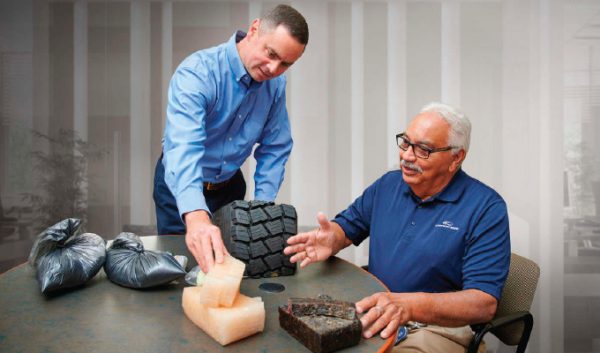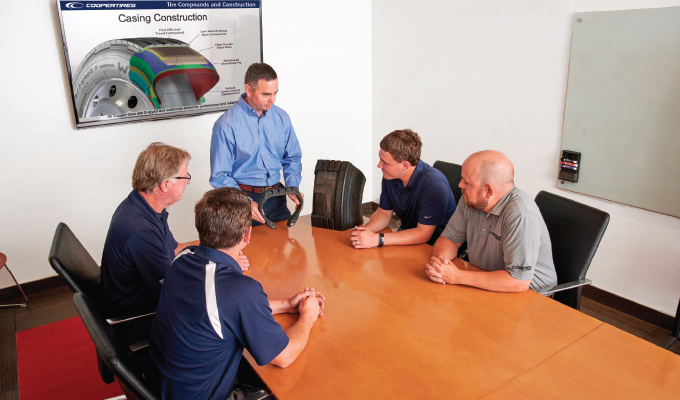Developing tire compounds is like baking bread. Mix together a few key ingredients and you’ve got the basic recipe. Flour, water, yeast, and sugar in the right amount and order will produce bread. Add in some extras like sweeteners, seeds, and butter, and you will create changes in taste and texture.
Commercial truck tires have basic ingredients too. It all starts with a mixture of mostly natural rubber and/or some synthetic rubber, filler materials (typically carbon black and silica), waxes, and oils as well as various chemical additives that promote elasticity, eco-friendliness, and durability. If rubber were not mixed with an additive like carbon black, a sooty by-product of the burning of oil that gives tires their blackness, the tread would be too soft and have no resistance to abrasion.
COMPOUNDS
Silica, a basic component of ordinary beach sand, is traditionally used to enhance cut/chip/chunk resistance. Tire engineers discovered in the 1970s that rolling resistance could be reduced and durability increased by replacing some of the carbon black with reacted silica in light tread vehicle tires. But there was a trade-off, especially when combined with natural rubber tread compounds in commercial tires—the lower rolling resistance could potentially affect abrasion and wear resistance.
Today, compounding engineers at Cooper work to develop the optimum mixture of ingredients that will create the perfect functionality for a particular application.
According to Phil Mosier, Cooper Tire’s manager of commercial tire development, “unpeel” a commercial tire and you’ll find 12 to 15 different compounds can go into one tire. There’s the tread, which makes contact with the road; underneath is the base to help dissipate heat; and other compounds go into the wire belt and the sidewalls of the tire. Because of the necessity for flexibility and tear and crack resistance in the sidewalls, Mosier says that tires often consist of a combination of natural and synthetic rubber compounds specially engineered to meet those requirements.
“Developing the compound formulations to achieve the desired balance of performance properties is a delicate task as many of the ingredient selections do provide both desirable and undesirable trade-off performance attributes,” Mosier explains. “Compounding keeps evolving as new materials are being developed and new fillers and chemicals are introduced to enhance fuel efficiency, grip, and cut and chip resistance, while also complying with new environmental regulations.”
TIRE INGREDIENTS
Depending on the part of the tire—tread, sidewalls, belts, or casing—there can be 30 to 40 ingredients in its rubber compounds. On average, it takes 22 gallons of petroleum to produce a new commercial tire. Much of that is for the production of process oils, chemicals, synthetic rubber, and carbon black. To replace some of the oil, manufacturers are considering a variety of sustainable, natural ingredients as substitutes.
Cooper led a consortium under a $6.9 million USDA grant to study guayule—a woody shrub grown primarily in the southwestern United States. It’s possible to extract natural rubber, latex, non-toxic adhesives, and other specialty chemicals from the shrub. Cooper built concept passenger tires based on this knowledge, and after extensive evaluation, including wheel and road tests, the guayule tires were found to have overall performance at least equal to tires made with natural and synthetic rubber. While the purpose of the study was strictly research, Cooper determined it could use guayule rubber if resources were available to meet production needs at a competitive price. (A video detailing this study is available at www.coopertire.com/guayule.)
Another alternative was also studied—Taraxacum kok-saghyz (TKS), the scientific name for a type of Russian dandelion. Cooper plays a key role in the Program of Excellence in Natural Rubber Alternatives (PENRA), a group dedicated to the development of TKS as a domestic natural rubber source. This consortium, led by The Ohio State University, is making progress in its research. The idea: breed a type of dandelion that yields a milky fluid with tire-grade rubber particles in its taproot.
“Beyond natural rubber sources, Cooper is continually studying new ingredients that may help improve tire performance,” Mosier says. “If we believe a material has promise, we will study it for its potential to be put into development.”
TESTING THE INGREDIENTS
Currently compound development has multiple stages. According to Mosier, Cooper’s engineering team puts mixes through tests designed to correlate with real-life conditions a rubber compound sees when on a vehicle. The most promising rubber compounds are vulcanized and tested under static and dynamic conditions. Cooper’s lab equipment is designed to test small rubber samples at different frequencies under various temperature settings from -148 to 212 degrees F.
“Tests to examine factors such as tensile strength ensure that compounds perform as expected and meet or exceed industry safety standards,” Mosier says. “After the tire is built and cured, it moves to wheel testing on a simulator that mimics real-world speeds and conditions. Once we are satisfied, field engineers work directly with customers to study how well the tires are performing in the day-to-day environments against our own control products as well as that of the competition.”
FOR ALL APPLICATIONS
Here’s a perfect example: 19.5-inch tires used on Class 4 and 5 trucks are used in a variety of applications such as package delivery, landscaping, and utility trucks. “When developing our new drive tire for this application, the Cooper Work Series ASD, customers wanted a tire that had good handling,” Mosier explains. “But we also knew it needed to perform consistently, not only on-highway but also on city streets and even in limited off road conditions. We went to the drawing board to develop a tire and tread compound that would meet the handling and traction requirements. We then did field testing with customers in different vocations. Through a marriage of a functional tread pattern and a well-balanced tread compound we were able to produce a tire that met our customers’ needs.”
Mosier offered another example. Waste haulers in major cities have a very specific job, and in the course of their work turn tight corners and do a lot of starting and stopping. The application requires a compound that provides excellent wear resistance.
Cooper developed a tire compound for waste hauler applications, and it performed well in testing, but frequent contact with curbs caused shoulder damage. “The solution was changing some of the internal polymers and fillers to improve the tear resistance of the tread cap without affecting the other properties of the tire,” Mosier says.
Cooper recently launched its Severe Series WBA commercial truck tire that provides long miles to removal while handling the harsh operating conditions found in construction truck applications. Special cut, chip, and chunk-resistant compounds, plus Cooper’s Scrub Guard™ technology, help the tire withstand scrubbing, curbs, and other obstacles typically encountered during operations to ensure longer tire life while maintaining casing integrity.
 A PERFECT RECIPE
A PERFECT RECIPE
“One of the biggest misconceptions that tire buyers have is that all rubber compounds are the same,” Mosier concludes. “That couldn’t be further from the truth. At Cooper, we never stop working to improve our tires. It all starts with the needs of the customer and ends with our work in the lab to come up with a solution.”
Although baking the perfect loaf of bread is usually done on a much smaller scale and with less testing, the concept of building the perfect tire for commercial applications is quite the same. Some ingredients can be substituted, some ingredients are must-haves, but as is the case with all recipes, sometimes all it takes is a little trial and error—or performance test and error—to achieve the best result.
FOR MORE INFORMATION
Find out more about Cooper tire compounds and testing, visit www.coopertire.com.




